
Dora Stock
Encyclopedia
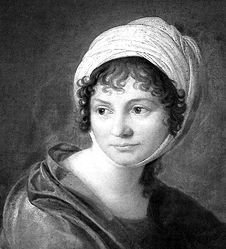
Johann Wolfgang von Goethe
Johann Wolfgang von Goethe was a German writer, pictorial artist, biologist, theoretical physicist, and polymath. He is considered the supreme genius of modern German literature. His works span the fields of poetry, drama, prose, philosophy, and science. His Faust has been called the greatest long...
, Schiller
Friedrich Schiller
Johann Christoph Friedrich von Schiller was a German poet, philosopher, historian, and playwright. During the last seventeen years of his life , Schiller struck up a productive, if complicated, friendship with already famous and influential Johann Wolfgang von Goethe...
and Mozart.
Childhood
She was born in Nürnberg to a copper engraver named Johann Michael Stock (1737–1773). Stock had in 1756 married a widow five years his senior—Maria Helen Endner, née Schwabe (1733–1782)—who already had a son, Georg Gustav, by her previous marriage. Dora was the first of two surviving children born to this marriage; two years later her younger sister Anna Maria Jakobina, called Minna (11 March 1762–1843), was born.When Dora was five years old, her father took up a position in Leipzig
Leipzig
Leipzig Leipzig has always been a trade city, situated during the time of the Holy Roman Empire at the intersection of the Via Regia and Via Imperii, two important trade routes. At one time, Leipzig was one of the major European centres of learning and culture in fields such as music and publishing...
working as an engraver and illustrator for the Breitkopf printing and publishing firm, and his family followed him to Leipzig a few months later. The Stock family was not well off. They lived in fifth-floor attic rooms in a building whose lower floors were occupied by Breitkopf printing facilities. The father worked in the front room, where there was ample window lighting, surrounded by his family.
As was common for children at the time (especially girls) Dora did not go to school; however, a local minister taught her basic skills of reading and arithmetic, and her mother taught her music; there was a modest piano in their home. The wealthy Breitkopf family also frequently invited her into their home, where she played with children receiving more substantial educations.
Goethe
Starting when Dora was six, her home was very frequently visited by Johann Wolfgang von GoetheJohann Wolfgang von Goethe
Johann Wolfgang von Goethe was a German writer, pictorial artist, biologist, theoretical physicist, and polymath. He is considered the supreme genius of modern German literature. His works span the fields of poetry, drama, prose, philosophy, and science. His Faust has been called the greatest long...
, who would eventually become the preeminent figure of German literature, but at the time was a 16-year-old studying jurisprudence at the university. Goethe had signed up with Dora's father for lessons in drawing and engraving.
The young Goethe taught Dora about the theater and led household performances in which Dora took parts. On the whole, however, his presence in the Stock household was disruptive and upsetting. In one typical episode, at Christmas time Goethe induced the family dog to eat the candy Christ-child. Goethe also required Dora and Minna to serve as lookouts whenever he entertained female company, and (to the family's concern) he took the father out drinking in Auerbachs Keller
Auerbachs Keller
Auerbachs Keller is the best known and second oldest restaurant in Leipzig. It was described in Johann Wolfgang von Goethe's play Faust I, as the first place Mephistopheles takes Faust on their travels....
, a scene later immortalized in Faust
Goethe's Faust
Johann Wolfgang von Goethe's Faust is a tragic play in two parts: and . Although written as a closet drama, it is the play with the largest audience numbers on German-language stages...
.
Goethe met the adult Dora and Minna a number of times in later years and remained on friendly terms with them. She never painted his portrait, however.
Training
The teenage Goethe had offered advice to Dora's father about how to raise his daughters: "[train them] in nothing but the art of housekeeping, let them be good cooks, that will be best for their future husbands." Her father however had no such intentions, and Dora assiduously learned the arts of drawing and engraving at his workbench; she was evidently his star pupil. Later Dora studied with Adam Friedrich OeserAdam Friedrich Oeser
Adam Friedrich Oeser was a German etcher, painter and sculptor.- Biography :Oeser worked and studied in Pressburg and Vienna at the Vienna Academy...
and (perhaps) Anton Graff
Anton Graff
Anton Graff was an eminent Swiss portrait artist. Among his famous subjects were Friedrich Schiller, Christoph Willibald Gluck, Heinrich von Kleist, Frederick the Great, Johann Gottfried Herder and Christian Felix Weisse...
, both painters. After the death of her father in 1773, Dora was able to help keep the family afloat, along with her older half-brother, by continuing the family's business relationship with Breitkopf.
Love life
In the late teenage years, she had two suitors, both of whom she turned down. In 1780, at age 20, became engaged to a 16-year-old, the future writer Ludwig Ferdinand HuberLudwig Ferdinand Huber
Ludwig Ferdinand Huber , German author, was born in Paris, the son of Michael Huber , who did much to promote the study of German literature in France....
. Since Huber had no means of supporting a family, the engagement was a very long one. In 1788, Huber left for a diplomatic position in Mainz
Mainz
Mainz under the Holy Roman Empire, and previously was a Roman fort city which commanded the west bank of the Rhine and formed part of the northernmost frontier of the Roman Empire...
; however, rather than making the marriage possible, it led to its cancellation: Huber embarked on a relationship with Therese Forster, the abandoned wife of Georg Forster
Georg Forster
Johann Georg Adam Forster was a German naturalist, ethnologist, travel writer, journalist, and revolutionary. At an early age, he accompanied his father on several scientific expeditions, including James Cook's second voyage to the Pacific...
, which Dora found out about only in 1792. Following this event, which Siegel characterizes as devastating, Dora made no further plans to marry and remained single for the rest of her life.
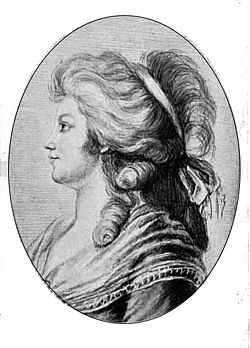
Stock and the Körners
Throughout her life Dora was very close to her younger sister Minna. Minna was engaged to Christian Gottfried KörnerChristian Gottfried Körner
Christian Gottfried Körner was a German jurist. His home was a literary and musical salon, and he was a friend of Friedrich Schiller.-Biography:...
shortly after he finished his university degree. Minna and Körner were unable to marry due to the strenuous objections of Körner's well-off father, who could not bear the thought of his son Gottfried marrying a "shop-keeper's girl".
In 1785 Körner's father died, leaving his son a substantial inheritance. This made it possible for Gottfried and Minna to marry. They did so on 7 August, and moved to Dresden
Dresden
Dresden is the capital city of the Free State of Saxony in Germany. It is situated in a valley on the River Elbe, near the Czech border. The Dresden conurbation is part of the Saxon Triangle metropolitan area....
, where Körner had earlier taken up a junior legal position (he eventually rose to a senior rank, consistorial councillor). Following their honeymoon, Dora moved in with them, occupying a small bedroom and setting up her painting apparatus in the common living area.
Gottfried, Minna, and Dora soon had made their home into an important cultural center. Robert Riggs writes:
- The Körner household in Dresden ... became a literary and musical salon. Plays and essays were read; SingspielSingspielA Singspiel is a form of German-language music drama, now regarded as a genre of opera...
e and chamber music were performed; and lectures on art were given. Guests and participants included Johann Gottfried von Herder, Goethe, Wilhelm von HumboldtWilhelm von HumboldtFriedrich Wilhelm Christian Karl Ferdinand Freiherr von Humboldt was a German philosopher, government functionary, diplomat, and founder of Humboldt Universität. He is especially remembered as a linguist who made important contributions to the philosophy of language and to the theory and practice...
, the SchlegelSchlegelSchlegel is a name of German origin, related to Schlägel "sledgehammer, mallet". It may refer to:-Places:*Schlegel, Saxony, a village in the district of Löbau-Zittau in Saxony belonging to the town of Zittau...
brothers, Ludwig TieckLudwig TieckJohann Ludwig Tieck was a German poet, translator, editor, novelist, writer of Novellen, and critic, who was one of the founding fathers of the Romantic movement of the late 18th and early 19th centuries.-Early life:...
, NovalisNovalisNovalis was the pseudonym of Georg Philipp Friedrich Freiherr von Hardenberg , an author and philosopher of early German Romanticism.-Biography:...
, and the musicians Johann Naumann, Johann Hiller, Karl Zelter, Mozart, and WeberCarl Maria von WeberCarl Maria Friedrich Ernst von Weber was a German composer, conductor, pianist, guitarist and critic, one of the first significant composers of the Romantic school....
.
The Körners had two children who survived past infancy. Both had short but high-achieving lives: Emma Körner
Emma Körner
Emma Sophie Körner was a German painter and a pupil of Anton Graff. She was the daughter of Christian Gottfried Körner and his wife Minna, who was the sister of the painter Dora Stock. Emma's brother was the poet and soldier Theodor Körner.-References:...
(1788–1815), who became a skilled painter, and Theodor Körner
Theodor Körner (author)
Karl Theodor Körner was a German poet and soldier. After some time in Vienna, where he wrote some light comedies and other works, he became a soldier and joined the German uprising against Napoleon...
(1791–1813), who became a renowned soldier-poet. Dora helped raise and educate both children, and painted portraits of them.
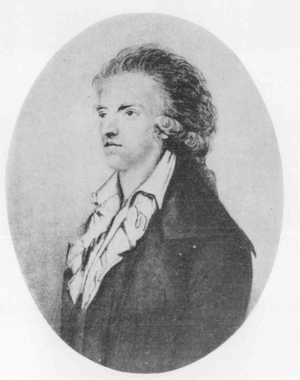
Relationship with Schiller
Starting in 1784 Dora, Huber, Minna, and Körner together befriended the poet Friedrich SchillerFriedrich Schiller
Johann Christoph Friedrich von Schiller was a German poet, philosopher, historian, and playwright. During the last seventeen years of his life , Schiller struck up a productive, if complicated, friendship with already famous and influential Johann Wolfgang von Goethe...
. The friendship began with an idea of Dora's, sending an anonymous package of token gifts (Dora's contribution was a miniature portrait of each of the four). This gesture greatly heartened Schiller, boosting his spirits at a difficult early phase of his career. In 1785 he visited the group and vacationed with them in Loschwitz
Loschwitz
Loschwitz is a borough of Dresden, Germany, incorporated in 1921. It consists of ten quarters :Loschwitz is a villa quarter located at the slopes north of the Elbe river...
, a rural village outside Dresden, eventually living for two years in the Körner household and remaining a lifelong friend. Dora produced three Schiller portraits.
In the Körner home Gottfried had built a small theater for family theatrical productions, which according to Siegel were good enough to attract professional theater people to the audience. Since Schiller was a close friend, this theater served as the venue for the (private) premieres of a number of his yet-unpublished plays; Siegel notes that Theodor Körner was the first to play the part of William Tell, and Stock herself was the first Joan of Arc (in The Maid of Orleans
The Maid of Orleans (play)
The Maid of Orleans is a tragedy by Friedrich Schiller, written in 1801 in Leipzig. During his lifetime, it was one of Schiller's most frequently-performed pieces.-Plot:...
). Stock also served as "director, stage manager, and the children's coach."
Artistic life
Dora Stock's art consisted almost entirely of portraits. Stock's biographer Linda Siegel describes and assesses these paintings in detail; in outline, she judges them as deeply thoughtful works, notable for their honesty and realism and not always flattering to their subjects. An anonymous reviewer of Siegel's book says of Stock that she "recoiled from vanity or exaggeration, values that are evident in her extremely competent and brutally honest portraits."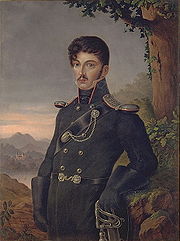
Silverpoint
Silverpoint is a traditional drawing technique first used by Medieval scribes on manuscripts.-History:A silverpoint drawing is made by dragging a silver rod or wire across a surface, often prepared with gesso or primer. Silverpoint is one of several types of metalpoint used by scribes, craftsmen...
. She was a gifted copyist, and according to Siegel "could not keep up with the number of requests for copies of works in the Dresden Paintings Gallery."
She was a member of the Dresden Academy of Art; her work was exhibited there five times during the years 1800–1813.
Later life
The years 1813–1815 were difficult and tragic ones for Stock. Dresden was in chaos from the terminal stages of the Napoleonic warsNapoleonic Wars
The Napoleonic Wars were a series of wars declared against Napoleon's French Empire by opposing coalitions that ran from 1803 to 1815. As a continuation of the wars sparked by the French Revolution of 1789, they revolutionised European armies and played out on an unprecedented scale, mainly due to...
, with the homes (the Körner home included) taken over by French soldiers and great numbers of civilian deaths. Stock's nephew Theodor, who had volunteered for the Freikorps
Lützow Free Corps
Lützow Free Corps was a voluntary force of the Prussian army during the Napoleonic Wars. It was named after its commander, Ludwig Adolf Wilhelm von Lützow. They were also widely known as "Lützower Jäger" or "Schwarze Jäger" .-Origins:...
to fight against Napoleon, died in action (1813); and niece Emma died of a short illness two years later, leaving the Körners childless. Stock, who had been like a second mother to her sister's children, was as devastated as Minna and Gottfried were. Finally, Gottfried fell into conflict with Frederick Augustus
Frederick Augustus I of Saxony
Frederick Augustus I was King of Saxony from the House of Wettin. He was also Elector Frederick Augustus III of Saxony and Duke Frederick Augustus I of Warsaw...
, the ruler of Saxony, and lost his job.
In 1815 the three moved to Berlin
Berlin
Berlin is the capital city of Germany and is one of the 16 states of Germany. With a population of 3.45 million people, Berlin is Germany's largest city. It is the second most populous city proper and the seventh most populous urban area in the European Union...
, where Gottfried had found a position as a civil servant, and there she spent the remainder of her life. She ceased to paint or draw after about 1821, due to illness.
The Mozart portrait
Probably the most famous of all Stock's portraits is her rendering of Wolfgang Amadeus MozartWolfgang Amadeus Mozart
Wolfgang Amadeus Mozart , baptismal name Johannes Chrysostomus Wolfgangus Theophilus Mozart , was a prolific and influential composer of the Classical era. He composed over 600 works, many acknowledged as pinnacles of symphonic, concertante, chamber, piano, operatic, and choral music...
. This may be the last portrait of Mozart made from life, and it is widely reproduced.
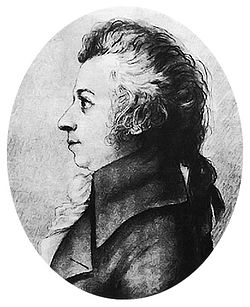
Mozart's Berlin journey
One of the longest adulthood journeys of Wolfgang Amadeus Mozart was a visit, beginning in Spring 1789, to a series of cities lying northward of his adopted home in Vienna: Prague, Leipzig, Dresden, and Berlin.-Departure:...
he made during Spring 1789. On either 16 or 17 April, 1789, Mozart made a social visit to the Körner home. Stock took the occasion to sketch a portrait of Mozart in silverpoint
Silverpoint
Silverpoint is a traditional drawing technique first used by Medieval scribes on manuscripts.-History:A silverpoint drawing is made by dragging a silver rod or wire across a surface, often prepared with gesso or primer. Silverpoint is one of several types of metalpoint used by scribes, craftsmen...
on ivory board, shown here.
Apparently silverpoint was not widely practiced at the time; Dora may have learned the medium from her father.
The portrait is quite small: 7.6 by 6.0 centimeters.
History of the portrait
Albi Rosenthal, the picture's one-time owner, indicates that the portrait was kept by Friedrich Körner (whom he does not identify) for some 50 years after it was made. Its further history was given by the German newspaper Die Welt: "the picture passed from the Körners to the conductor Carl EckertKarl Anton Eckert
Karl Anton Florian Eckert was a German conductor and composer.Eckert was born in Berlin, Germany, and by the age of five, had already proved himself as a musical child prodigy...
; later it was possessed by Henri Hinrichsen, the owner of the C. F. Peters
Edition Peters
Edition Peters, also known as C.F.Peters Musikverlag, is a German music publishing house, founded in Leipzig in 1800.From the 1860s it was largely run by members the Hinrichsen family, who were Jewish. The company was confiscated by the Nazis and administered by the "Trustee of Jewish Property"....
music publishers of Leipzig
Leipzig
Leipzig Leipzig has always been a trade city, situated during the time of the Holy Roman Empire at the intersection of the Via Regia and Via Imperii, two important trade routes. At one time, Leipzig was one of the major European centres of learning and culture in fields such as music and publishing...
. He was murdered in Auschwitz in 1942. His heirs gave the picture to the Rosenthal family in thanks for their help."
Albi Rosenthal died in 2004. At the end of 2005, his heirs sold the picture to the Mozarteum in Salzburg
Salzburg
-Population development:In 1935, the population significantly increased when Salzburg absorbed adjacent municipalities. After World War II, numerous refugees found a new home in the city. New residential space was created for American soldiers of the postwar Occupation, and could be used for...
for 250,000 British pounds. Being very fragile, it is kept in the museum's protective vaults; only a replica is on display.
Stock's Mozart anecdote
Long after her death, Gustav Parthey published a book called Jugenderinnerungen ("Remembrances of youth", 1871). He related a tale about Mozart's visit that Dora Stock had told him during her lifetime:- Mozart himself, during his short stay in Dresden, was an almost daily visitor to the Körners' house. For the charming and witty Doris he was all aflame and with his south Germanvivacity he paid her the naïvest compliments. He generally came shortly before dinner and, after he had poured out a stream of gallant phrases, he sat down to improviseImprovisationImprovisation is the practice of acting, singing, talking and reacting, of making and creating, in the moment and in response to the stimulus of one's immediate environment and inner feelings. This can result in the invention of new thought patterns, new practices, new structures or symbols, and/or...
at the pianoforte. In the next room the table was meanwhile being set and the soup dished up, and the servant announced that dinner was served. But who could tear himself away when Mozart was improvising! The soup was allowed to grow cold and the roast to burn, simply so that we could continue to listen to the magic sound which the master, completely absorbed in what he was doing and unaware of the rest of the world, conjured from the instrument. Yet one finally grows tired even of the highest pleasures when the stomach makes known its demands. After the soup had grown cold a few times while Mozart played, he was briefly taken to task. "Mozart", said Doris, gently laying her snow-white arm on his shoulder, "Mozart, we are going in to dine; do you want to eat with us?" But it was precisely Mozart who never did come; he played on undisturbed. Thus we often had the rarest Mozartian musical accompaniment to our meal, Doris concluded her narrative, and when we rose from table we found him still sitting at the keyboard.
Deutsch (reference below) notes that the anecdote probably exaggerates the number of times that Mozart visited the Körner home. The house was on the street in Dresden now called the Körnergasse.

